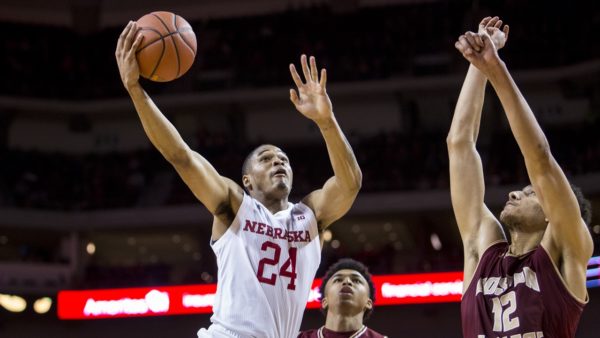In Search of a Big Ten Darkhorse? Look No Further Than Nebraska…
Posted by Tommy Lemoine on January 8th, 2018Nebraska’s 15-point trouncing of Northwestern last week was a statement win for the Huskers, and not just because it marked their first road victory of the season. It was the confidence Tim Miles’ group played with — dominating the final eight minutes of the contest — that opened eyes in both Allstate Arena and beyond. Defensively, Nebraska held the Wildcats to 0.89 points per possession on just 29.2 percent shooting; offensively, the team’s go-to playmakers came through when it counted. “I think it… solidifies our vision of what we can be. Like, ‘You know what? This is possible,’” Miles said afterward. With a roster that’s deep, experienced and chock full of high-performing transfers, what Nebraska ‘can be’ is a surprise competitor in the Big Ten this season.

Nebraska was one of just three Big Ten teams to win a game in the ACC-Big Ten Challenge. (James Wooldridge, Daily Nebraskan)
- Playmakers. The most striking difference between this year’s Nebraska team and those of recent past is the number of athletic playmakers on its roster. The infusion of several key transfers — namely Isaac Copeland (Georgetown) and James Palmer, Jr. (Miami (FL)) — has given the Huskers multiple players capable of finishing at the rim. Palmer, who leads the team with 15.6 points per game, has emerged as the team’s most dynamic offensive weapon, adept at using his length to both attack the basket (53.4% FTRate) and shoot over smaller defenders (35% 3FG). The now-healthy Copeland (12.4 PPG, 6.5 RPG) — who averaged double-figures in the Big East as a sophomore — is showing flashes of what made him a five-star recruit coming out of high school. Meanwhile, point guard Glynn Watson, Jr. (12.1 PPG) remains one of the quickest players in the league, his ability to penetrate at will enabling the Huskers to pull away from Northwestern last week. Miles, discussing the importance of guys like Palmer, Copeland and Watson, put it simply: “We’ve got more guys that can make plays.”
- Quality Depth. Nebraska’s rotation runs about 10 players deep with 32.6 percent of its minutes coming off the bench. While that’s only a slight uptick from last season, the quality of depth — players capable of bringing a unique skill set off the bench — is markedly better. In addition to Palmer and Copeland, former Louisville transfer Anton Gill — a once-heralded recruit whose career has been defined by injuries — has emerged as Nebraska’s most dangerous perimeter threat, averaging 48.6 percent shooting from behind the arc. Winthrop transfer Duby Okeke has provided crucial rim protection in limited minutes. As sophomore Isaiah Roby (6.8 PPG, 4.7 RPG) looks more and more like a potential future all-league talent, so does four-star freshman Thomas Allen, who scored 13 points in 14 minutes against Kansas. The Huskers have so many options this season, in fact, that forward Jack McVeigh — a starter in 2016-17 — has been phased out of the rotation. “The idea that some guys can have off nights and we still win is huge,” Miles recently said
- Experience. On paper, Nebraska is the third-most experienced team in the Big Ten (2.02 years of experience), with four of its top five scorers all upperclassmen. But years of service alone doesn’t necessarily mean much if none of those guys have played in meaningful basketball games. Amazingly, the Huskers have that, too. Despite not reaching the postseason since 2014, Nebraska has four players on its roster — Copeland, Palmer, Okeke and Gill — who have played in NCAA Tournament contests. Copeland once scored 14 points in a second-round loss to Utah in 2015. Having players on the roster who have been to the Dance — and know what it takes to get there — should be an invaluable asset for Miles during the thick of conference play.
- Attitude. Much like their fiery and energetic coach, the Cornhuskers have adopted a certain swagger this season that’s hard to ignore. Need proof? Look no further than Copeland’s posterizing dunk (and subsequent technical foul) over Purdue center Isaac Haas on Saturday. Or the energy they played with against Kansas. Or the way Nebraska went into attack mode late in the second half against Northwestern, sparked by this Palmer slam. “We found some attitude in our team,” Copeland said after that game. “You’ve got to have some grit and some anger.”
- How far can they go? Make no mistake — Nebraska is not a Big Ten title contender this season. At 11-6 (2-2 Big Ten), the Huskers firmly exist somewhere within the league’s vast, muddled middle. Still, unlike some of its peers, Miles’ team has talent and confidence enough to make some unexpected noise during conference play. Already with wins over Minnesota and Northwestern, Nebraska responded impressively on Saturday after falling behind by 15 points early at Purdue, cutting the lead to single-digits several times before ultimately losing by 12. “I was proud of our guys in terms of the mentality of really not flinching,” Miles said afterwards. His team’s KenPom ranking (#81) is the highest since 2014, and the Huskers return home — where they’ve lost only once this season — for three of their next four contests. Nebraska has a very real chance to finish .500 or better in conference play for the first time since 2013-14, which happens to be the last time it reached the NCAA Tournament. With some quality wins under its belt and no terrible losses to speak of (yet), that, too, is not out of the question.









































